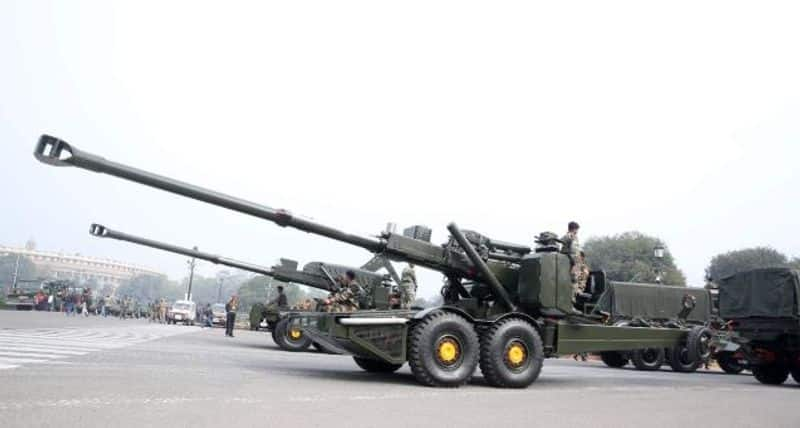Made-in-India Dhanush will be the third type of artillery guns to be inducted by the Army after K-9 Vajra and M-777 ultra-light howitzers. The Indian Army had been desperately looking for 155-mm howitzers for more than a decade now.
New Delhi: Amid tension with neighbouring Pakistan and China, the Narendra Modi government has expedited several key defence projects for modernising of the forces. Adding more firepower to Indian artillery, the Indian Army will commission the first batch of six Dhanush howitzer guns on March 26.
India’s first indigenous, long-range artillery gun Dhanush, which some refer to as the ‘desi Bofors’, will be inducted at a ceremony that will be held at the Gun Carriage Factory in Jabalpur.
The DRDO and the Ordnance Factory Board had kicked-off the programme to upgrade the design of the Bofors gun obtained under a transfer-of-technology pact. Dhanush will be the third type of artillery guns to be inducted by the Army after K-9 Vajra and M-777 ultra-light howitzers. It is expected that, by the end of the year, a regiment consisting of 18 guns will be deployed along the China and Pakistan borders.
The made-in-India gun was showcased for the first time also at the Republic Day parade. The Army has ordered a total of 110 such guns which would play a big role in modernising its artillery. The Army had been desperately looking for 155-mm howitzers for more than a decade now.
Also Read; It's time to snatch Pakistan's nuclear weapons
The guns are manufactured by the Jabalpur-based Gun Carriage Factory (GCF), each of the artillery guns cost around Rs 14.50 crore. Every shell of the gun costs Rs 1 lakh.
The Gun Carriage Factory received the Dhanush project in October 2011 and the first prototype was made in 2014. Later, 11 more prototypes were made from which 4,200 rounds were fired.
The guns have passed tests in extreme cold in Sikkim and Leh and also in hot and humid weather conditions in Balasore, Odisha, and Babina in Jhansi. It also worked perfectly in the deserts of Pokhran in Rajasthan.
Dhanush has a strike range of 38 km and 81% of its components are indigenously sourced; this will go up to 90 per cent by the end of this year.
The gun is equipped with inertial navigation-based sighting system, auto-laying facility, on-board ballistic computation and an advanced day and night direct firing system.
The self-propulsion unit allows the gun to negotiate and deploy itself in mountainous terrains with ease.
Dhanush has been mechanically upgraded to fire standard NATO 155 mm ammunition and can accommodate the bi-modular charge system (BMCS) which has resulted in increasing the range. It has also been electronically upgraded to enhance the firing accuracies, laying speeds of the existing gun and to provide compatibility with various kinds of ammo as well.
The performance of the gun has been evaluated under extreme conditions in several phases.
The guns travelled extensively in a towed and self-propelled mode in all terrains like deserts and high altitude with each gun clocking over 1,600 km. Such an extensive exercise was carried out by the user for the first time for any gun system under the process of induction.
The gun has passed tests under severe cold conditions in Sikkim and Leh and in hot and humid weather in Balasore, Odisha, Babina in Jhansi and in the desert of Pokhran in Rajasthan. Besides features like electronic gun-laying and sighting systems, the indigenous gun's hitting range was 11 km more than the imported Bofors guns.
During the trial in Pokhran, the muzzle and barrel of the howitzer exploded twice. A probe by different Ministry of Defence departments into the two incidents, however, did not find any fault with the gun. Later, Dhanush was found to be among the finest artillery guns in terms of accuracy.
Dhanush is the product of joint efforts by the OFB and the Army with contributions from the DRDO, DGQA, DPSUs such as Bharat Electronics Limited, PSUs such as SAIL and several private enterprises.
Six years ago, the Defence Acquisition Council had decided to look for artillery guns within the country and asked OFB to start manufacturing howitzers. According to defence experts, the Army needs a huge number of howitzers of different types, and Indian firms, some in partnership with foreign manufacturers, are in the race to fulfil the demand.
Last Updated Mar 25, 2019, 7:49 PM IST











![Salman Khan sets stage on fire for Anant Ambani, Radhika Merchant pre-wedding festivities [WATCH] ATG](https://static-ai.asianetnews.com/images/01hr1hh8y86gvb4kbqgnyhc0w0/whatsapp-image-2024-03-03-at-12-24-37-pm_100x60xt.jpg)
![Pregnant Deepika Padukone dances with Ranveer Singh at Anant Ambani, Radhika Merchant pre-wedding bash [WATCH] ATG](https://static-ai.asianetnews.com/images/01hr1ffyd3nzqzgm6ba0k87vr8/whatsapp-image-2024-03-03-at-11-45-35-am_100x60xt.jpg)



